Victor Borisov-Musatov Biography
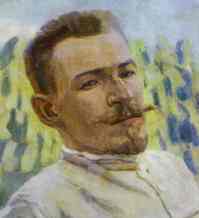
Victor Musatov (he appended the name Borisov later) was born on April 14, 1870 in Saratov, Russia, in the family of a minor railway official who had been a serf. In his early childhood he had suffered a bad fall, which left him humpbacked for the rest of his life. The tact and understanding of his parents, who encouraged his fondness for art, and the lessons of the young painter Konovalov contributed much to the formation of his artistic personality.
In 1890 Musatov left his native town to enroll in the Moscow School of Painting, Sculpture and Architecture. Dissatisfied with the system of teaching at the school, which was then going through a severe crisis, he left for St. Petersburg a year later, hoping to receive better professional training at the capital's Academy of Fine Arts. But the conservative academic system of training did not appeal to him, and only in the private school of Tchistyakov, a well-known teacher of the Academy, could he work with real enthusiasm. The damp climate of St. Peterburg told on Musatov's health and made him return to Moscow in 1893, where he renewed his studies at the Moscow School. Musatov's earliest works, shown at a students' exhibition, were sharply criticized and labeled decadent. They brought the displeasure of the school authorities upon him, but at the same time evoked warm sympathy in his fellow students. Due to his energy and resolution he finally became the leader of a circle of young painters bent on discovering new methods in art.
In 1895 Musatov left the Moscow School and went to Paris, where he worked for three winters, perfecting his drawing skills in the school of Fernand Cormon, a mediocre painter of historical subjects who was, however, an excellent teacher. His contact with contemporary French painting had a decisive effect on his life and work. "My artistic possibilities widened," said Musatov later. "Much of what I had dreamt of I now saw achieved and this led to more ambitious dreams as I saw new horizons in my work." He got to know Impressionism in its pure, "classical" manifestation. He was fascinated by the works of Berthe Morisot, her sunny paintings – free and bold and at the same time full of feminine tenderness. He was already familiar with some features of Impressionism, but others, as, for example, the Impressionist and Neo-Impressionist technique of the divided stroke, he studied with great attention. At the same time he was deeply interested in the works of Symbolists, who attracted him with their sincerely poetic vision of the world or, as he called it, their "dream of harmony." He especially admired the paintings of the father of Symbolism, Puvis de Chavannes, the idol of all young painters who yearned for "dreams, emotions and poetry." He regarded Puvis' murals as a revival of monumental decorative painting, an art form he was to aspire to all his life.
Musatov spent the summer months of 1896 and 1897 in Saratov, working tirelessly on his studies. In his little garden on a quiet street leading down to the Volga he painted small boys in the nude, attempting to convey the changes of color caused by the changing daylight. He also did many sketches and studies of his younger sister, who constantly sat for him. All this was preparatory work for the large canvases he was to paint later.
In 1898 Musatov finally returned to Russia. Almost immediately after his return, Musatov fell into depression, which is now termed "fin de siècle nostalgia." The reason for this was his painfully acute reaction to many aspects of the reality which surrounded him, the social contradictions of "the cruel, the truly iron age." Musatov's desire to escape from this "dirt and boredom," this "devil's bog," from the spirit of money-grabbing and the petty bourgeois life around him became more pressing. He found a way out, at least spiritually, in creating a unique pictorial world, half invented, half realistic. A similar escape into their personal world of feeling and images was the fate of many Russian and European artists, poets and composers at the turn of the century. These were also the years when Musatov abandoned the technique of oil painting. Tempera, along with watercolor and pastel, became his favorite medium.
1901 was the beginning of a period when Musatov's talents came into full bloom. His main work of 1901 was Tapestry. The very name indicates the decorative tasks posed by the painter. In Tapestry the artist created a world of his own. He rejected all narrative elements; he brushed aside everything that was incidental, transient that interfered with the transformation of the actual things into a harmonious abstract image. The young women in this painting are, as it were, a reflection of the real prototype (Musatov's sister was his model for both women), but their features are generalized to a degree that makes it impossible to speak of any portrait likeness.
In such works as Spring, Tapestry and Lady Embroidering many historians of Russian art saw a kinship between Musatov and the World of Art Society and some even thought him to have been a member of that group. In the second half of 1902 the artist painted The Pool. For Musatov himself The Pool was his most important picture. The picture is at once monumentally decorative, realistic and poetic, filled with intense lyrical feeling. Similarly, the two young women, day-dreaming in the peace of a summer afternoon, were not vague visions from the past but poetic portrayals of the artist's two most cherished companions – his sister and his bride, his future wife, artist Yelena Alexandrova.
Phantoms is a picture which seems to have been born of a windy, gloomy autumn evening. Wisps of mist became for the artist the specters of the women who had lived here, but had long since passed away. Slowly they glide by in the elusive bluish-gray twilight. The women, the tree, and the house are seen by the painter as in a dream…. It was the first time too, that he had come so close to the Russian literary Symbolism of the early 20th century in an attempt not only "to understand his own hidden and vague emotions" (Briusov), but also to penetrate the mysterious "world of shadows," the irrational world of the "true essence" of objects and phenomena.
For a number of years Musatov was prominent as one of the organizers of exhibitions of the Moscow Association of Artists, a progressive organization that had brought together his followers, Pavel Kuznetsov, Peter Utkin and Alexander Matveyev, Martiros Saryan, Nikolai Sapunov, and Sergei Sudeikin. His reputation grew. His Tapestry, The Pool and other paintings shown at the exhibitions, attracted the attention of artistic circles, though the press continued to treat his art skeptically. His contacts with painters in St. Petersburg, - Alexander Benois, Evgeni Lancarey, and Diaghilev – increased. He also maintained friendly relations with the Moscow Symbolist poets Valery Briusov and Andrei Beliy.
Early in 1904 Musatov had highly successful one-man shows in a number of cities in Germany; in the spring of 1905 his paintings, including The Pool, were exhibited at the Salon de la Société des Artistes Française in Paris, and he was elected a member of the society. Nevertheless Musatov's financial position remained difficult, and it was only during the last two years of his life that art collectors began to buy his pictures.
Musatov's last work was Requiem, a large, minutely detailed watercolor, dedicated to the memory of Nadezhda Staniukovich, a close friend of the artist. Musatov's deep grief at her untimely death is expressed in abstract classical forms. The park, where a procession of women passes in front of an ethereal palace, is seen as a stilled, frozen "Elysium of the dead." In the center is a woman oblivious of all worldly things, her features reveal a portrait likeness of the deceased. She is depicted in different moods at the beginning and the end of the procession: first youthful and calm, then sorrowful and tragic. Despite a greater detailing than in his other pictures, the women in Requiem are transformed into shadows. Replacing a living image with a symbol, Musatov comes here much closer to Symbolism in its mystical aspect than in any other of his earlier paintings: the elements of Art Nouveau in his Requiem come into contact or actually merge with the strict and impressive forms of Neo-Classicism.
Borisov-Musatov died on October 26, 1905.
Bibliography
Borisov-Musatov. By A.A. Rusakova. Leningrad. 1974. (in Russian)
Borisov-Musatov. Russian Painters series. Aurora. Leningrad. 1975.
Borisov-Musatov. By L. Mochalov. Leningrad. 1976. (in Russian)
Borisov-Musatov. By K. Shilov. Moscow. 1985. (in Russian)
- Tapestry.
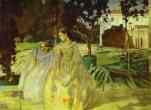
1901. Tempera on oil. The Tretyakov Gallery, Moscow, Russia.
- Spring.
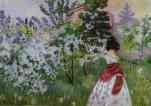
1898-1901. Tempera on canvas. The Russian Museum, St. Petersburg, Russia.
- Lady Embroidering.
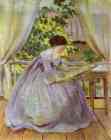
1901. Tempera on canvas. The Russian Museum, St. Petersburg, Russia.
- The Pool.
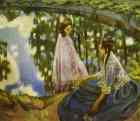
1902. Tempera on canvas. The Tretyakov Gallery, Moscow, Russia.
- Phantoms.
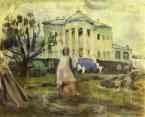
1903. Tempera on canvas. The Tretyakov Gallery, Moscow, Russia.
- Autumn Evening.

1904-05. Sketch for a panel. Watercolor, pencil. The Tretyakov Gallery, Moscow, Russia.
- Requiem.
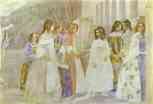
1905. Watercolor. The Tretyakov Gallery, Moscow, Russia.
- Window.
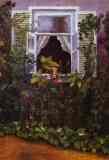
1886. Oil on canvas. The Tretyakov Gallery, Moscow, Russia.
- In A Boat.
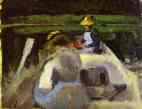
1892-94. Oil on canvas. The A. N. Radishchev Museum of Arts, Saratov, Russia.